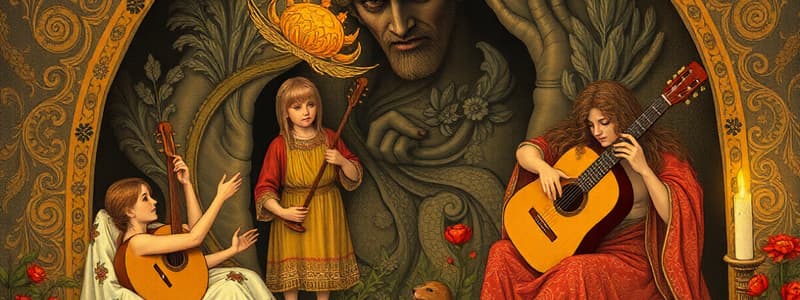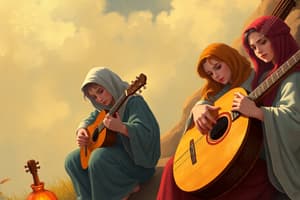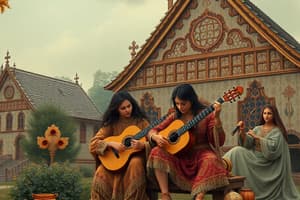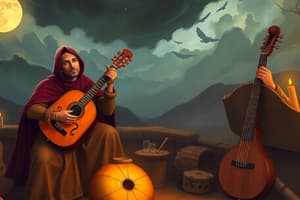Podcast
Questions and Answers
What purpose did music serve in early cultures?
What purpose did music serve in early cultures?
- Solely for religious rituals and ceremonies.
- For communication, entertainment, celebrations, and work. (correct)
- For communication with extraterrestrial life and celestial objects.
- Primarily for entertainment and leisure.
In the context of early music, what was the role of a shaman in the Altai Republic, Russia?
In the context of early music, what was the role of a shaman in the Altai Republic, Russia?
- To lead communal singing and dancing during celebrations and rituals.
- To mimic natural sounds to communicate with the spirit world while in a trance. (correct)
- To compose complex melodies and rhythms for entertainment purposes.
- To craft musical instruments from animal bones and natural materials.
What is the significance of the Divje Babe Flute?
What is the significance of the Divje Babe Flute?
- It is a complex wind instrument with intricate carvings.
- It is one of the oldest surviving musical instruments, made from animal bone. (correct)
- It is believed to have been used in ancient theatrical performances.
- It is the oldest known complete musical score.
What materials did early people use to create musical sounds?
What materials did early people use to create musical sounds?
What did Simon Thorne attempt to reconstruct in 2009?
What did Simon Thorne attempt to reconstruct in 2009?
Where was the Divje Babe Flute discovered?
Where was the Divje Babe Flute discovered?
What were some essential musical elements in early cultures of the Solomon Islands?
What were some essential musical elements in early cultures of the Solomon Islands?
Which specific materials and actions were mentioned to have been made into whistles?
Which specific materials and actions were mentioned to have been made into whistles?
Flashcards
Early Music Performance
Early Music Performance
Exploration of music creation by mimicking natural sounds and using tools.
Indigenous Traditions
Indigenous Traditions
Cultural practices that continue ancient music-making heritage.
Toe-bone Whistle
Toe-bone Whistle
A musical instrument made from animal toe bones, dating to 40,000 BCE.
Clapping in Music
Clapping in Music
Signup and view all the flashcards
Shaman
Shaman
Signup and view all the flashcards
Divje Babe Flute
Divje Babe Flute
Signup and view all the flashcards
Natural Sound Mimicking
Natural Sound Mimicking
Signup and view all the flashcards
Early Music Functions
Early Music Functions
Signup and view all the flashcards
Study Notes
Early Music Performance
- Early humans were inspired by natural sounds like animals, water, and tools
- Music was used for communication, entertainment, and celebration
- Music was passed down orally from generation to generation
- Indigenous traditions are a continuation of ancient heritage
Sounds of the Neanderthals
- In 2009, Simon Thorne reconstructed Neanderthal sounds using a team of scientists
- They used flint tools and human vocalizations to create the sounds
- Neanderthals may have used their voices and tools to make music
Toe-Bone Whistle
- 40,000 BCE, France
- Whistles were made from animal toe bones (e.g., caribou)
- These were found at early human excavation sites.
Clapping
- Solomon Islands
- Clapping, singing, and dance were part of early music traditions
- Musical gestures were important in early cultures
Shaman
- Altai Republic, Russia
- Shamans, who were priests and healers, went into a trance-like state
- Imitated natural animal sounds to communicate with spirits
Divje Babe Flute
- 40,000 BCE, Slovenia
- Made from an animal bone
- Found in a cave and is one of the oldest surviving musical instruments
Listening to Sounds
- Listen to sounds around your house like humming and ticking
- Create rhythms and melodies with household objects like pans, shoes, and pencils
Studying That Suits You
Use AI to generate personalized quizzes and flashcards to suit your learning preferences.





